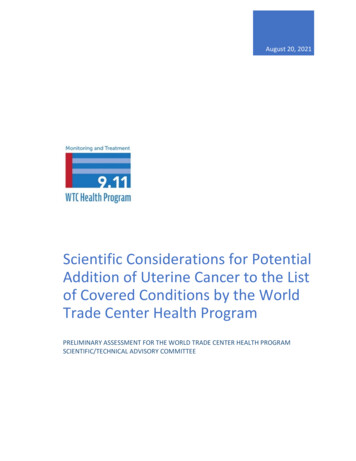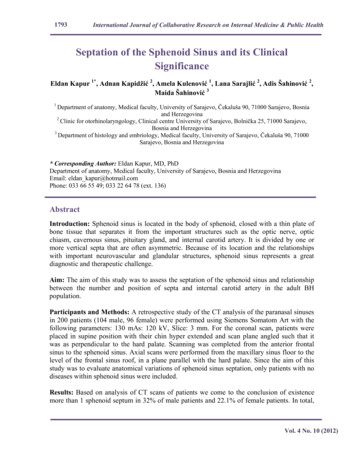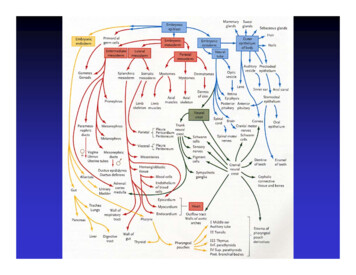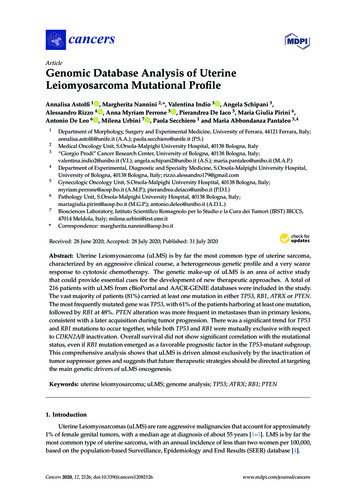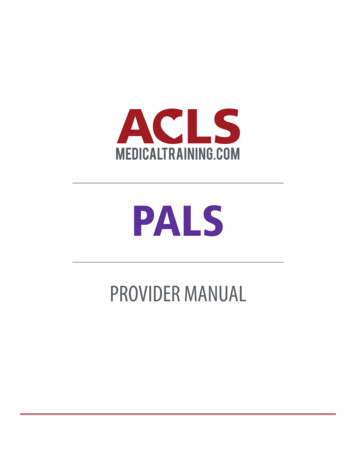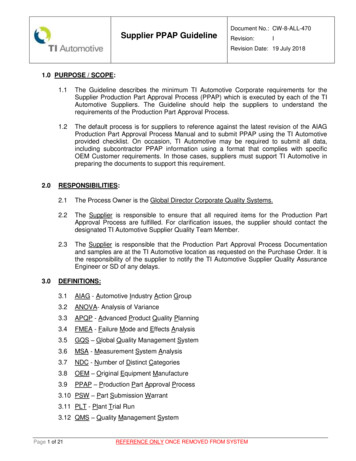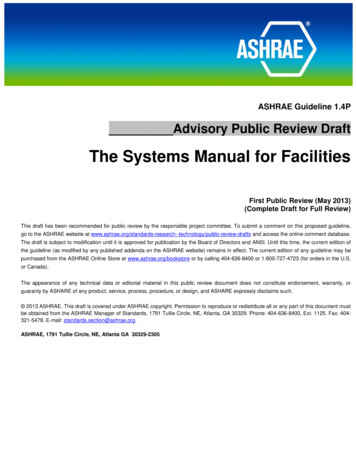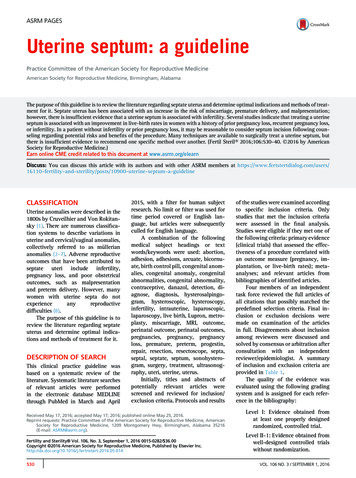
Transcription
ASRM PAGESUterine septum: a guidelinePractice Committee of the American Society for Reproductive MedicineAmerican Society for Reproductive Medicine, Birmingham, AlabamaThe purpose of this guideline is to review the literature regarding septate uterus and determine optimal indications and methods of treatment for it. Septate uterus has been associated with an increase in the risk of miscarriage, premature delivery, and malpresentation;however, there is insufficient evidence that a uterine septum is associated with infertility. Several studies indicate that treating a uterineseptum is associated with an improvement in live-birth rates in women with a history of prior pregnancy loss, recurrent pregnancy loss,or infertility. In a patient without infertility or prior pregnancy loss, it may be reasonable to consider septum incision following counseling regarding potential risks and benefits of the procedure. Many techniques are available to surgically treat a uterine septum, butthere is insufficient evidence to recommend one specific method over another. (Fertil SterilÒ 2016;106:530–40. Ó2016 by AmericanSociety for Reproductive Medicine.)Earn online CME credit related to this document at www.asrm.org/elearnDiscuss: You can discuss this article with its authors and with other ASRM members at delineCLASSIFICATIONUterine anomalies were described in the1800s by Cruveilhier and Von Rokitansky (1). There are numerous classification systems to describe variations inuterine and cervical/vaginal anomalies,collectively referred to as m ulleriananomalies (2–7). Adverse reproductiveoutcomes that have been attributed toseptate uteri include infertility,pregnancy loss, and poor obstetricaloutcomes, such as malpresentationand preterm delivery. However, manywomen with uterine septa do notexperienceanyreproductivedifficulties (8).The purpose of this guideline is toreview the literature regarding septateuterus and determine optimal indications and methods of treatment for it.DESCRIPTION OF SEARCHThis clinical practice guideline wasbased on a systematic review of theliterature. Systematic literature searchesof relevant articles were performedin the electronic database MEDLINEthrough PubMed in March and April2015, with a filter for human subjectresearch. No limit or filter was used fortime period covered or English language, but articles were subsequentlyculled for English language.A combination of the followingmedical subject headings or textwords/keywords were used: abortion,adhesion, adhesions, arcuate, bicornuate, birth control pill, congenital anomalies, congenital anomaly, congenitalabnormalities, congenital abnormality,contraceptive, danazol, detection, diagnose, diagnosis, hysterosalpingogram, hysteroscopic, hysteroscopy,infertility, intrauterine, laparoscopic,laparoscopy, live birth, Lupron, metroplasty, miscarriage, MRI, outcome,perinatal outcome, perinatal outcomes,pregnancies, pregnancy, pregnancyloss, premature, preterm, progestin,repair, resection, resectoscope, septa,septal, septate, septum, sonohysterogram, surgery, treatment, ultrasonography, uteri, uterine, uterus.Initially, titles and abstracts ofpotentially relevant articles werescreened and reviewed for inclusion/exclusion criteria. Protocols and resultsReceived May 17, 2016; accepted May 17, 2016; published online May 25, 2016.Reprint requests: Practice Committee of the American Society for Reproductive Medicine, AmericanSociety for Reproductive Medicine, 1209 Montgomery Hwy, Birmingham, Alabama 35216(E-mail: ASRM@asrm.org).Fertility and Sterility Vol. 106, No. 3, September 1, 2016 0015-0282/ 36.00Copyright 2016 American Society for Reproductive Medicine, Published by Elsevier .014530of the studies were examined accordingto specific inclusion criteria. Onlystudies that met the inclusion criteriawere assessed in the final analysis.Studies were eligible if they met one ofthe following criteria: primary evidence(clinical trials) that assessed the effectiveness of a procedure correlated withan outcome measure (pregnancy, implantation, or live-birth rates); metaanalyses; and relevant articles frombibliographies of identified articles.Four members of an independenttask force reviewed the full articles ofall citations that possibly matched thepredefined selection criteria. Final inclusion or exclusion decisions weremade on examination of the articlesin full. Disagreements about inclusionamong reviewers were discussed andsolved by consensus or arbitration afterconsultation with an independentreviewer/epidemiologist. A summaryof inclusion and exclusion criteria areprovided in Table 1.The quality of the evidence wasevaluated using the following gradingsystem and is assigned for each reference in the bibliography:Level I: Evidence obtained fromat least one properly designedrandomized, controlled trial.Level II-1: Evidence obtained fromwell-designed controlled trialswithout randomization.VOL. 106 NO. 3 / SEPTEMBER 1, 2016
Fertility and Sterility TABLE 1Summary of inclusion/exclusion criteria.Inclusion criteriaLevel 1, 2-1, 2-2, 2-3 studies; systematicreviews/meta-analysesHuman studiesEnglishStudies that report clinical (fertility and/orobstetrical) outcomesStudies that focus on septate, arcuate,bicornuate uterine anomalies and/oradhesionsExclusion criteriaLevel 3 studies: small series, case reports, reviews, opinions, off topicAnimal studiesNon-EnglishStudies that focus on prevalence with no fertility and/or obstetrical outcome measuresStudies that do not focus on septate uterus, but focus on unicornuate or didelphic uteri, orfibroids and polyps, or cervix and vagina, obstructed hemivagina and ipsilateral renal anomaly(OHVIRA) or Herlyn-Werner-Wunderlich (HWW), Asherman, Fryns, or Mayer-Rokitansky ster-Hauser (MRKH) syndromeKuStudies with a focus on amenorrhea, blood flow, cancer, dysmenorrhea, endometriosis,hemodynamics, menorrhagia, ovarian maldescent, polycystic ovary syndrome, surgicaltechnique only, uterine horn, uterine prolapse, vascular endothelial growth factor (VEGF)Studies with a focus on pediatric or postpartum populationStudies with a focus on abdominal metroplastyASRM. Uterine septum. Fertil Steril 2016.Level II-2: Evidence obtained from well-designed cohortor case-control analytic studies, preferably frommore than one center or research group.Level II-3: Evidence obtained from multiple time serieswith or without the intervention. Dramatic results inuncontrolled trials might also be regarded as thistype of evidence.Level III: Opinions of respected authorities based on clinical experience, descriptive studies, or reports of expertcommittees.Systematic reviews/meta-analyses were individuallyconsidered and included if they followed a strict methodological process and assessed relevant evidence.The strength of the evidence was evaluated as follows:Grade A: There is good evidence to support the recommendations, either for or against.Grade B: There is fair evidence to support the recommendations, either for or against.Grade C: There is insufficient evidence to support the recommendations, either for or against.Number of studies identified in an electronic search andfrom examination of reference lists from primary and reviewarticles ¼ 1,034; number of studies included ¼ 204.DEVELOPMENTA uterine septum is believed to develop as a result of failure ofresorption of the tissue connecting the two paramesonephric(m ullerian) ducts prior to the 20th embryonic week. While thearcuate uterus represents the mildest form of resorption failure, unlike the septum, it is not considered clinically relevant.The true prevalence of the uterine septum is difficult to ascertain as many uterine septum defects are asymptomatic, butappear to range between 1 to 2 per 1,000 to as high as 15per 1,000 (8). Initially, uterine septa were believed to be predominantly fibrous tissue. However, biopsy specimens andVOL. 106 NO. 3 / SEPTEMBER 1, 2016magnetic resonance imaging (MRI) suggest that septa arecomposed primarily of muscle fibers and less connective tissue (9, 10).M ullerian anomalies in general may be associated withrenal anomalies in approximately 11% to 30% of individuals(5). However, data do not exist to suggest an association between septate uterus and renal anomalies and, as such, it isnot necessary to evaluate the renal system in all patientswith a uterine septum.Septate uteri have a spectrum of configurations includingincomplete/partial septate to complete septate uterus. A partial septate uterus refers to a single fundus and cervix with auterine septum extending from the top of the endometrialcavity toward the cervix. The size and shape of the septumcan vary by width, length, and vascularity, although mosthave not been categorized systematically, and definitionsare not standardized. For example, the definition of theseptum by the European Society of Human Reproductionand Embryology and the European Society for GynecologicalEndoscopy (ESHRE-ESGE) criteria is an internal indentationextending 50% of myometrial wall thickness (7), while theAmerican Society for Reproductive Medicine (ASRM) criteriaprovide no strict parameters to define septate configurations(2, 3, 11). Some authors have proposed additionalmorphologic criteria for the American Fertility Society(AFS) criteria to better characterize and differentiate aseptate from an arcuate uterus. These authors define apartial uterine septum as having the central point of theseptum at an acute angle (to differentiate from an obtuseangle seen with an arcuate configuration) (12) and definethe length of the septum to be greater than 1.5 cm, witharcuate defined as having a fundal invagination between 1and 1.5 cm (13). As there is no universally acceptedstandard definition of septate uterus, differences among theavailable definitions may lead to variability in diagnosticclassifications with correspondingly higher/lower incidenceof surgery performed to correct these anomalies (11).Figure 1 represents the ASRM proposed definition of aseptate uterus compared with arcuate and bicornuate uterus.531
ASRM PAGESFIGURE 1Diagrams of the ASRM definitions of normal/arcuate, septate, and bicornuate uterus based on assessment of available literature, understandingthat these anomalies reflect points on a spectrum of development. Normal/arcuate: depth from the interstitial line to the apex of theindentation 1 cm and angle of the indentation 90 degrees. Septate: depth from the interstitial line to the apex of the indentation 1.5 cmand angle of the indentation 90 degrees. Bicornuate: external fundal indentation 1 cm. Internal endometrial cavity is similar to a partialseptate uterus.ASRM. Uterine septum. Fertil Steril 2016.A complete septate uterus has a single uterine fundus,with a septum extending from the top of the endometrial cavity and continuing through the cervix or may extend into aduplicated cervix. Both may be seen in combination with alongitudinal vaginal septum. This configuration must bedifferentiated from the uterus didelphys in which the uterinehorns are separated. Both of these anomalies have duplicatedcervices and typically are associated with a longitudinalvaginal septum.In addition, a combined bicornuate/septate configurationof the uterus has been described in which the external fundushas an indentation consistent with a bicornuate shape, but athysteroscopy there is a septum dividing the endometrial cavities (14). Radiologic descriptions of this anomaly describe thefundus as not convex but rather with a fundal indentationthat should be less than 1 cm, with greater than 1 cm moreconsistent with a pure bicornuate uterus (15, 16). Inaddition, the septum may be variable in length and width,and the cervix may be single, septate, or duplicated.The arcuate uterus is difficult to classify. Althoughdevelopmentally the arcuate uterus may be considered aspart of the spectrum of failure of m ullerian resorption, itis typically considered a normal variant and thereforefunctionally not part of the septate spectrum. The AFS classification system placed arcuate uterus in its own categoryas, in contrast to other uterine malformations, it does notcause adverse clinical outcomes (3). However, it is important to differentiate arcuate from septate uterus to betterdirect surgical intervention when appropriate for theseptate uterus. Arcuate describes a uterus with an externally normal-appearing fundus and a small smooth indentation at the top of the endometrial cavity (3). There is nostandard definition of the arcuate configuration, nor isthere a widely accepted defining depth of the indentationinto the endometrial cavity to differentiate it from septate.Descriptions of an arcuate shape in the literature are variable. Definitions include vague descriptions of a concave532indentation into the endometrial cavity and vary fromdefining the angle making up the fundal portion of themyometrium protruding into the cavity as obtuse (to differentiate from the acute angle seen with a uterine septum), todefining the indentation to be less than 1.0–1.5 cm andinclude an obtuse angle (12, 13, 17, 18), and to definingthe ratio of the depth of fundal indentation to thedistance between the two uterine horns of less than 10%(19) (Fig. 1).As a result of the numerous and varied definitions and terminology used to describe septate uteri, it is challenging tointerpret the data regarding pre-treatment and post-treatmentoutcomes and ultimately determine optimal management.DIAGNOSIS OF SEPTATE UTERUSHistorically, the gold standard method for diagnosing m ullerian anomalies required direct visualization of the exteriorand interior of the uterus using laparoscopy and hysteroscopy. Importantly, assessing both the outer and inner uterinecontour makes it possible to distinguish a septate from a bicornuate uterus. As radiologic methods have improved overthe past 20 years, the diagnosis of a septate uterus is typicallymade using radiographic rather than surgical techniques.While hysterosalpingography (HSG) is often the initial testthat provides evidence for a m ullerian anomaly in patientswith infertility or recurrent pregnancy loss, the diagnostic accuracy of the HSG is low for distinguishing septate and bicornuate uteri. Indeed, compared with hysteroscopy/laparoscopy, several studies indicate that the diagnostic accuracy of HSG ranges from 5.6% to 88% (20–23). Some studiessuggest that sonohysterography or saline infusionsonography (SIS) is superior to HSG since it is possible toassess the external as well as internal contour of the uterus.However, studies are limited since there has not been aconsistent gold standard diagnostic method used forcomparison nor a consistent definition of these anomaliesVOL. 106 NO. 3 / SEPTEMBER 1, 2016
Fertility and Sterility (13, 24). A study of 117 females found that the use of 3dimensional (3-D) ultrasonography combined with salineinfusion had 100% accuracy when compared with laparoscopy/hysteroscopy (25). Also, 3-D ultrasound without salineinfusion has been found to be over 88% accurate for diagnosing uterine septa in two studies when compared with hysteroscopy/laparoscopy (25, 26). MRI is often used for thediagnosis of m ullerian anomalies. There are few datacomparing the diagnostic accuracy of MRI compared withlaparoscopy/hysteroscopy. However, several studies haveshown a high level of agreement between MRI and otherradiologic techniques (10, 18). One study suggests thatwhile MRI is an accurate method to diagnose m ullerianabnormalities overall, it is only 70% accurate for thediagnosis of uterine septum (16).It must be emphasized that studies to determine how tobest diagnose a septum are limited by small sample sizes andare from select centers. Therefore, it is likely that interpretationof radiologic studies depends on the experience of the interpreter. It is important when confirming the diagnosis of septateuterus that the external uterine contour as well as the internalconfiguration of the endometrial cavity are assessed.Therefore, HSG or hysteroscopy alone is inadequate. Whenthe diagnosis of a uterine septum is not clear, it may be helpfulto seek consultation with a clinician with experience in thediagnosis and management of m ullerian anomalies.Summary statements: There is fair evidence that 3-D ultrasound, sonohysterography, and MRI are good diagnostic tests for distinguishing a septate and bicornuate uterus whencompared with laparoscopy/hysteroscopy. (Grade B) It is recommended that imaging with hysteroscopyshould be used to diagnose uterine septa rather thanlaparoscopy with hysteroscopy because this approachis less invasive (Grade B).LIMITATIONS OF THE LITERATUREThe data regarding reproductive implications of a uterineseptum are limited, making firm recommendations regardingtreatment difficult. Only observational, principally descriptive studies without untreated control groups have been conducted to assess the reproductive consequences of a uterineseptum. Importantly, there are no prospective randomizedcontrolled trials (RCTs) that compare surgical treatment of aseptum with no intervention. Many studies fail to adequatelydefine the characteristics of uterine septa, and there are manydifferent surgical techniques described. In addition, there aresubstantial differences among studies principally because theindication for septum incision varies widely. Studies includewomen with unexplained infertility, a single first-trimesterloss, recurrent pregnancy loss, or no adverse reproductive history. Moreover, studies have inconsistent follow-up data andsometimes do not report live-birth outcomes. This guidelinewill review the uterine septum literature for the diagnosis ofinfertility, pregnancy loss, reproductive outcomes, surgicaltechnique, and postoperative prevention of intrauterineadhesions.VOL. 106 NO. 3 / SEPTEMBER 1, 2016‘‘Uterine septum resection’’ is the term commonly used todescribe all surgical procedures performed to treat a uterineseptum. Initial procedures, such as the Jones metroplasty,described resection and removal of the uterine septum withsubsequent uterine closure. However, most hysteroscopictechniques currently used involve incision rather than resection (or removal) of the septum. Therefore, for the purpose ofthis document, the term ‘‘uterine septum incision’’ will be usedwhen referring to hysteroscopic procedures to treat a uterineseptum as it more correctly reflects the predominant surgicaltechnique utilized.Summary statement: The data regarding reproductive implications of septateuteri and treatment effects are limited and comprisedprimarily of observational, principally descriptivestudies without untreated control groups.DOES A SEPTUM IMPACT FERTILITY?Uterine septa are often diagnosed during an infertility evaluation. The incidence of uterine septa in this population hasbeen noted to be higher than in the general population, suggesting a link with infertility (27–30). Given that infertilitycan be the result of multiple factors, it is often difficult todetermine if the uterine septum is the sole reason for theinfertility. Several small descriptive studies have evaluatedthe relationship between uterine septa and infertility. One ofthe larger studies compared 153 women with all types ofuterine anomalies to a control group of 27 women with anormal uterus (30). In the 33 women diagnosed with aseptate uterus there was a higher incidence of infertilitycompared with controls (21.9% vs 7.7%); however, thisdifference did not reach statistical significance (30). Onestudy evaluated infertility in women with m ulleriananomalies compared with those with external genitalanomalies and a normal uterus. When all other causes hadbeen excluded, infertility was not seen more frequently inthe 17 women with a septate uterus (27). In another study,33 women were followed prospectively for 24 months afterhysteroscopic diagnosis of arcuate and septate/bicornuateuteri (31). There was no difference in cumulative pregnancyrates or monthly fecundity when compared with those witha normal-shaped cavity. In a more recent study, 92 womenwith a septate uterus were identified at laparoscopy and hysteroscopy performed for miscarriage or infertility (primary orsecondary) and compared with 191 women found to have anormal uterus (32). Primary infertility was less common inthose with a septate uterus compared with controls (43.5%vs 64.9%, P¼ .001) (32). However, in a meta-analysis evaluating the effect of congenital uterine anomalies on reproductive outcomes, septate uterus was the only anomaly that wasassociated with a significant decrease in the probability ofnatural conception when compared with controls (relativerisk [RR] 0.86, 95% confidence interval [CI], 0.77–0.96) (33).Summary statement: There is insufficient evidence to conclude that a uterineseptum is associated with infertility. (Grade C)533
ASRM PAGESDOES TREATING A SEPTUM IMPROVEFERTILITY IN INFERTILE WOMEN?Although there is insufficient evidence supporting the association between septate uterus and infertility, there are manystudies in which women with a uterine septum and the diagnosis of infertility underwent septum incision and the subsequent effect on pregnancy was assessed. There are norandomized controlled studies evaluating this intervention,and the majority of the studies are small observational studieswith untreated controls.One study evaluated 193 women with primary infertilityof at least 2 years’ duration. Following septum incision thecumulative pregnancy probability was 10% in the first6 months, 18.1% in the first 6–12 months, and 23.3% after18 months (34). A retrospective study involving 127 womendiagnosed with unexplained infertility, normal semen analysis, and a uterine septum found that subsequent pregnancyrates in the 102 women who underwent septum incisionwere significantly higher than in the 25 women who chosenot to undergo septum incision during a follow-up periodof 14 months from time of diagnosis or treatment (43.1% vs20%, P¼ .03), despite no significant difference in age, timeto pregnancy, body mass index (BMI), or septum classification(35). In a prospective study, 44 women with a septate uterusand no other causes of infertility were compared with 132women with unexplained infertility (36). Both groups werefollowed expectantly for 1 year without fertility treatment,but the septum group was initially treated with hysteroscopicseptum incision. At 12 months, the group that underwentseptum incision had a higher pregnancy rate of 38.6%compared with 20.4% in the unexplained infertility group(P .05). In another prospective study 88 patients with aseptate uterus and 2 years of unexplained infertility (allcauses excluded) underwent septum incision. Following surgery, 41% of the patients conceived with a median time toconception of 7.5 2.6 months (37). In women 35 yearsof age, 82.4% conceived while 17.6% did not (P .001), whilenone of the women 40 years of age conceived. The pregnancy rate was higher in women with 3 years comparedwith R3 years of unexplained infertility (75% vs. 15%). Aretrospective matched controlled study evaluated theoutcome following embryo transfer in three groups of patients: patients with a uterine septum (n ¼ 289), patientswho underwent hysteroscopic septum incision (n ¼ 538),and matched controls (n ¼ 1,654) (28). Study and control populations were matched for age, BMI, stimulation protocol,quality of embryos, use of in vitro fertilization (IVF) or intracytoplasmic sperm injection (ICSI), and infertility indication.Pregnancy and live-birth rates were significantly lower inthose with a uterine septum compared with controls (12.4%vs. 29.2%, P¼ .001; 2.7% vs. 21.7%, P¼ .001, respectively).Pregnancy and live-birth rates following septum incisionwere not significantly different compared with controls(22.9% vs. 26.0%, not significant [NS]; 15.6% vs. 20.9%,NS, respectively). Pregnancy rates were higher in the groupthat had undergone septum incision compared with thosewho did not undergo incision of their uterine septum (odds ratio [OR] 2.507, 95% CI, 1.539–4.111, P .001).534Summary statement: Several observational studies indicate that hysteroscopic septum incision is associated with improvedclinical pregnancy rates in women with infertility.(Grade C)DOES A SEPTUM CONTRIBUTE TOPREGNANCY LOSS OR ADVERSE PREGNANCYOUTCOME?Although many women with a uterine septum have an uncomplicated reproductive history, septate uteri have beenimplicated in pregnancy loss and poor obstetrical outcomes.The studies evaluated for this guideline are relatively smalldescriptive studies, and there are no RCTs. All studies suggestthat a septate uterus is associated with a higher rate of miscarriage as well as higher preterm delivery rates when comparedwith controls.One of the larger studies evaluated 689 women found tohave a septate uterus during diagnostic evaluation in aninfertility clinic (38). Their reproductive outcomes werecompared with obstetric outcomes in 15,060 women in thegeneral pregnant population. The incidence of early miscarriage was 41.1% in patients with septate uterus comparedwith 12.1% in the control population. Late abortions and premature deliveries developed in 12.6% of patients with septateuterus compared with 6.9% in the general population. Inanother study uterine morphology was assessed in 1,089women without a history of infertility or recurrent pregnancyloss, and findings were correlated with their reproductive history (12). In this group, 983 women were found to have anormal uterine cavity and 29 women were identified as having a partial uterine septum. The rate of first-trimester miscarriage was higher in women with a septate uterus comparedwith those with a normal uterine cavity (42% vs. 12%,P .01). However, the rates of second-trimester miscarriageand preterm labor were no different in the septate groupversus controls (second-trimester loss 3.6% vs. 3.5%; pretermlabor 10.5% vs. 6.2%, respectively). Another study retrospectively evaluated pregnancy outcome in all women identifiedwith a m ullerian anomaly treated at a single institutionover a 14-year period compared with a control group madeup of pregnant women found to have a genital or urinary tractanomaly but with a normal uterus (30). Thirty-three womenidentified as having a septate uterus were noted to have ahigher early abortion rate compared with controls (36.2%vs. 9.1%, P .001) and a lower term-birth rate comparedwith controls (37.9% vs. 84.8%, P .001). In a study of IVFpatients, 289 embryo transfers were performed in womenwith a septate uterus before correction and compared with1,654 consecutive embryo transfers in controls without uterine abnormalities matched for age, BMI, stimulation protocol,quality of embryos, use of IVF or ICSI, and infertility indication (28). The miscarriage rate in the septate uterus group wassignificantly higher compared with controls (77.1% vs.16.7%, P .001).A meta-analysis evaluated the effect of congenital uterineanomalies on reproductive outcomes and found that septateVOL. 106 NO. 3 / SEPTEMBER 1, 2016
Fertility and Sterility uterus was associated with a higher risk of adverse pregnancyoutcomes (33). Women with a septate uterus were noted tohave a higher rate of first-trimester miscarriage whencompared with controls (RR 2.65, 95% CI, 1.39–5.06). Whenevaluating other pregnancy complications, the pooled relativerisk of adverse outcomes for women with a septate uteruscompared with controls was as follows: preterm delivery 37 weeks 2.11 (95% CI, 1.51–2.94), malpresentation at delivery 4.35 (95% CI, 2.52–7.50), intrauterine growth restriction2.54 (95% CI, 1.04–6.23), placental abruption 4.37 (95% CI,1.12–17.08), and perinatal mortality 2.43 (95% CI, 1.10–5.36).Summary statements: There is fair evidence that a uterine septum contributesto miscarriage and preterm birth. (Grade B) Some evidence suggests that a uterine septum may increase the risk of other adverse pregnancy outcomessuch as malpresentation, intrauterine growth restriction, placental abruption, and perinatal mortality.(Grade B)DOES TREATING A SEPTUM IMPROVEOBSTETRICAL OUTCOMES?There are many retrospective studies that evaluate obstetrical outcomes following hysteroscopic septum incision;however, there are no prospective randomized trials. In addition, there is significant heterogeneity within and betweenthese studies, and indications for surgery are variable. However, the majority of studies suggest that a uterine septumleads to a higher pregnancy loss rate, and septum incisionleads to improved miscarriage rates and obstetricaloutcomes.One of the largest studies to evaluate this question was aretrospective case series of 361 patients with septate uterus(including total, subtotal, and duplicated cervices) who hadprimary infertility of 2 years’ duration, a history of 1–2spontaneous miscarriages, or recurrent pregnancy loss (34).In women with a history of miscarriages, the miscarriagerate decreased from 91.8% to 10.4% following septum incision. In this group the live-birth rate prior to surgery was4.3% while after septum incision the live-birth rate increasedto 81.3%. In the recurrent pregnancy loss group, the miscarriage rate decreased from 94.3% to 16.1% following septumincision and the live-birth rate also improved from 2.4% to75% after surgery. A large retrospective study evaluatedreproductive outcomes following hysteroscopic incision ofuterine septum in 90 women with recurrent pregnancy losswith a mean follow-up of 37 18 months (39). In this group,65.3% of patients achieved a pregnancy and the miscarriagerate was 34.1%. In another large observational study womenwith a uterine septum undergoing IVF were found to have ahigher rate of abortion compared with controls (77.1% vs.16.7%, P .001), but after septum incision the abortion ratewas not significantly different when compared with controls(29.2% vs. 18.4%) (28). In
Uterine septum: a guideline Practice Committee of the American Society for Reproductive Medicine American Society for Reproductive Medicine, Birmingham, Alabama

